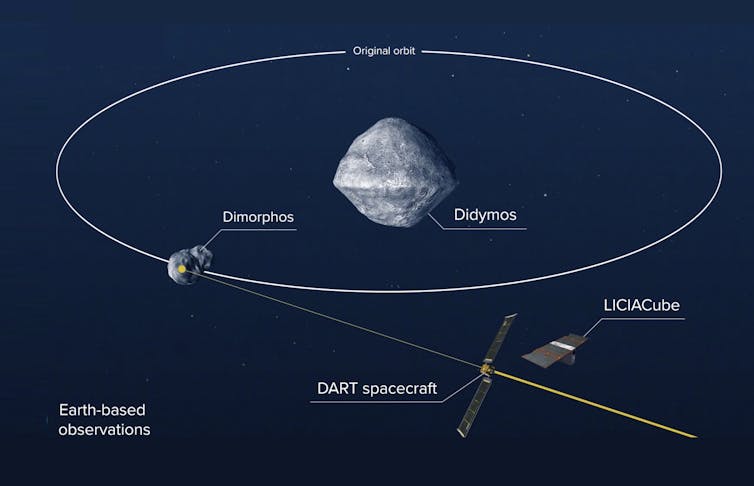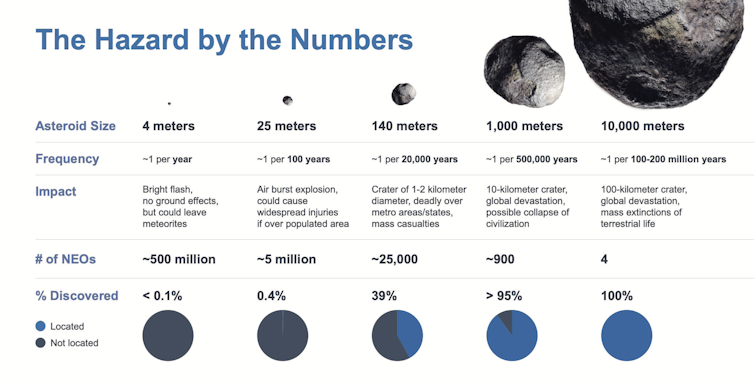On September 26 at 11.15pm UTC, NASA’s DART mission (Double Asteroid Redirection Test) will be the first to deliberately and measurably change the motion of a significant body in our Solar System. In other words, it will smash into an asteroid.
The mission will provide the first test of a technique that could be used in the future – to redirect any asteroids we detect on a collision course with Earth.
A binary pair of space rocks
DART was launched on November 24, 2021, its destination a pair of asteroids in orbit around each other, 11 million kilometres from Earth.
The larger asteroid in the pair is called Didymos and is 780 metres in diameter. The smaller asteroid, just 160 metres wide, is called Dimorphos. The two orbit each other at a distance of 1.18 kilometres, and one orbit takes close to 12 hours.

These asteroids pose no risk to Earth and have been chosen as the target for DART partly due to that fact. But also, importantly, because the asteroids form a binary pair, it will be possible for astronomers on Earth to assess the results of the impact.
As the asteroids orbit each other, the sunlight reflected off them increases and decreases, varying systematically over the 12-hour cycle of the orbit. Astronomers using powerful telescopes from Earth can monitor this variation and see how it changes, from before to after the collision.
The physics is simple, the mission is not
The physics sounds simple, and it is. Hit one thing with another thing to change its motion. But the mission execution is very complicated. When DART reaches the asteroids, it will be 11 million kilometres from Earth after a 10 month journey. The spacecraft has to use autonomous targeting, using images of the asteroids it acquires as it approaches.
DART needs to recognise the asteroids by itself, automatically lock onto Dimorphos, and adjust its trajectory to hit it. This is all while moving at a speed of nearly 24,000 kilometres per hour!
The results of the impact, while reasonably straightforward to measure, are difficult to predict. The size, shape, and composition of Dimorphos, and exactly where DART hits and how hard, will affect the outcome.
All these factors are uncertain to some degree. Comprehensive computer simulations of the impact have been undertaken, and the comparisons of the simulations, predictions, and measured results will be the main outcomes of the DART mission.
As well as the measurements from telescopes on Earth, an up-close view of the impact itself will be possible, from an Italian Space Agency CubeSat (a small type of satellite) called LICIACube that was deployed from a spring-loaded box aboard the craft on 11 September. LICIACube will follow along and photograph the collision and its aftermath.

The results will tell us a lot about the nature of asteroids and our ability to change their motions. In the future, this knowledge could be used to plan planetary defence missions that seek to redirect asteroids deemed to be a threat to the Earth.
What is the level of threat?
An asteroid as small as 25 metres in diameter could produce injuries from an airburst explosion if it hit the atmosphere over a populated area. It is estimated that 5 million such objects exist in our Solar System and that we have discovered approximately 0.4% of them. Such a hit is estimated to occur once every 100 years. While quite frequent, the overall risk is low and the impact risk is relatively low too.
However, it is predicted there are 25,000 objects in the Solar System the size of Dimorphos, 39% of which are known, that hit Earth every 20,000 years. Such an object would cause mass casualties if it hit a populated area.

Asteroids that could challenge the existence of human civilisation are in the 1 km plus size category, of which there are less than a thousand in the Solar System; they might hit Earth only every 500,000 years. We have already found 95% of these objects.
So, potential asteroid collisions with Earth range from the frequent but benign to the very rare but catastrophic. The DART tests are being undertaken in a very relevant and interesting size range for asteroids: those greater than 100 metres.
If DART is successful, it may set the scene for future missions that target asteroids, to nudge them out of the way of collisions with Earth. When an asteroid is a long way from Earth, only a small nudge is required to get it out of our way, so the earlier we can identify asteroids that are a potential threat, the better.
In the near future, the well-worn premise of so many “an asteroid is coming, we need to deflect it!” movies may well become a reality.
Read more: Mystery crater potentially caused by relative of dinosaur-killing asteroid

